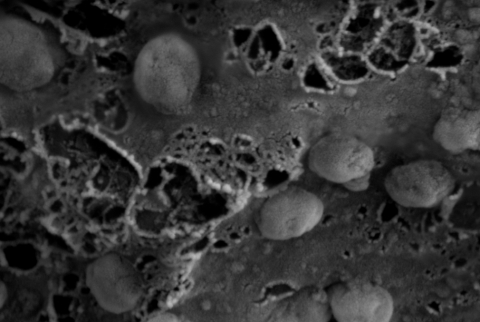[ad_1]
Scientists have developed a an anti-HIV protein called ZPAMt which can be delivered to affected areas using exosomes, nanoscale parts of cells that can reach hard-to-reach areas of the body, such as the brain.
DUARTE, Calif .– (BUSINESS WIRE) – Researchers from City of Hope, a world-renowned cancer and diabetes research and treatment organization, and Griffith University’s Menzies Health Institute Queensland have developed a new anti-HIV protein that suppresses HIV in the bone marrow, spleen and brain of mice and prevented the virus from replicating in these regions, according to a new study published today in Nature Communications.
This press release features multimedia. View the full release here: https://www.businesswire.com/news/home/20210920005213/en/

A high power microscope image showing exosomes, nanoscale parts of cells. (Credit: Surya Shrivastava / City of Hope)
Their research shows that scientists could design nanoscale parts of cells called exosomes to carry therapeutic cargo to hard-to-reach places, including the nearly impenetrable blood-brain barrier. This innovative delivery system paves the way for a future where it is conceivable that modified exosomes can carry a cargo that either suppresses infectious diseases or restructures genetic material so that pathogens are rendered harmless.
“This innovative technology could become a viable way to provide therapies not only for HIV but also for other diseases, including those that affect the brain, such as Alzheimer’s disease and Parkinson’s disease,” said Professor Kevin Morris, Ph.D. of the City of Hope Gene Therapy Center and Griffith University School of Pharmacy and Medical Sciences. Morris is the lead author of the new study.
The human immunodeficiency virus attacks cells that help the body fight infection, making an individual more vulnerable to other infections and diseases. Many researchers believe that one way to cure HIV is to “block and lock” the disease in a process that hinders the virus’s ability to replicate and locks it in a dormant state.
“The ZPAMt HIV protein repressor we have developed is packaged in nanoparticles of exosomes and can enter cells where it epigenetically silences HIV,” Morris said. “We show that these nanoparticles can systematically ‘block and lock in’ the expression of HIV. This is the first time that blocking and locking have been successfully administered to treat HIV in vivo in the brain. “
HIV can enter the human body in a dormant state; it is able to hide from the body’s immune system and evade treatment. Then it can reactivate later. HIV hidden in the brain is particularly difficult to treat because of the blood-brain barrier, which prevents both toxins and therapies from entering the brain.
Currently, there is no cure for HIV, so once someone gets it, he or she will have it for life. An estimated 1.19 million people in the United States were HIV-positive at the end of 2019, according to the Centers for Disease Control and Prevention.
The research was funded by the National Institute of Mental Health, National Institutes of Health (R01 113407-01).
About City of Hope
City of Hope is an independent center for biomedical research and treatment of cancer, diabetes and other life-threatening diseases. Founded in 1913, City of Hope is a leader in bone marrow transplantation and immunotherapy such as CAR T cell therapy. City of Hope translational research and personalized treatment protocols advance care around the world. Human synthetic insulin, monoclonal antibodies and many revolutionary cancer drugs are based on technology developed at the institution. A comprehensive cancer center designated by the National Cancer Institute and a founding member of the National Comprehensive Cancer Network, City of Hope is ranked among the “Best Hospitals” in the country for cancer by US News & World Report. Its main campus is located near Los Angeles, with additional locations in Southern California and Arizona. Translational Genomics Research Institute (TGen) became part of City of Hope in 2016. AccessHopeMT, a subsidiary launched in 2019, is at the service of employers and their healthcare partners by giving them access to the expertise of cancer centers designated by the NCI. For more information on City of Hope, follow us on Facebook, Twitter, YouTube or Instagram.
About Griffith University
Griffith University is a comprehensive research-intensive university ranked in the top 2% of world universities with 50,000 students spread across six campuses in South East Queensland, Australia. Its research excellence, innovative teaching and learning practices, and close links with industry make it one of the leading providers of higher education in Asia-Pacific.
See the source version on businesswire.com: https://www.businesswire.com/news/home/20210920005213/en/
[ad_2]
Source link